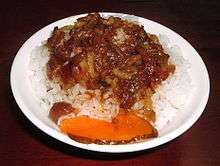Minced pork rice
Minced pork rice (or lo bah png, Chinese: 滷肉飯; pinyin: lǔròufàn; Pe̍h-ōe-jī: ló͘-bah-pn̄g) is a rice dish that is commonly seen throughout Taiwan and Southern Fujian.[1] The flavor may vary from one region to another, but the basic ingredients remain the same: ground pork marinated and boiled in soy sauce served on top of steamed rice. It is a type of gaifan dish.
.jpg) Minced pork rice with other common Taiwanese dishes | |
| Place of origin | Taiwan |
|---|---|
| Region or state | Southern Fujian |
| Main ingredients | ground pork, rice |
| Minced pork rice | |||||||||||
|---|---|---|---|---|---|---|---|---|---|---|---|
| Traditional Chinese | 滷肉飯 | ||||||||||
| Literal meaning | braised meat rice | ||||||||||
| |||||||||||

Origin
How the dish was developed is not as clear. According to a study by a professor from the Department of History of Taiwan, a similar meat sauce dish dates back to at least China's Zhou Dynasty. The Book of Rites records: "In a saucepan cook meat, and stir after adding seasoning until mostly browned sauce, then pour the meat sauce on cooked rice." There is also a description of these foods in the novel "Water Margin" by Suzhounese writer Shi Nai'an.[2] In time, the dish developed into countless regional variations. These different varieties can be found all over China with the Taiwanese version bearing strongest resemblance to those found in Southern Fujian.[3] This gives credence to the theory that minced pork rice was brought to Taiwan by Fujianese immigrants.[4][5]
Etymology
According to Shuowen Jiezi (說文解字, Explaining Simple and Analyzing Compound Characters), the word "Lu (滷)" has the closest meaning to "cooking in thick broth or sauce." This gives the term "滷肉飯" the direct meaning of "rice with braised meat."
However, for several decades, many Taiwanese people have used the homophone "魯" instead of "滷". Although people still use the original character in China, "魯肉飯" has become the most common name seen in Taiwanese restaurants and street vendors. 魯 is the ancient name for the Chinese province of Shandong, which led the Michelin Green Guide Taiwan to write in April 2011 that minced pork rice originated from Shandong. This confusion then led to a fierce debate[6] in which most Taiwanese insisted that minced pork rice was in reality a true symbol of Taiwan, while others viewed it as a Chinese dish that caught on in Taiwan.
Since minced pork rice was first recorded in the Zhou Dynasty, it is entirely possible that the dish did originate in Shandong or close by in the region of North China.[7] Taiwanese gourmets Hu Tianlan and Zhu Zhenduo agree that it is highly likely that the dish originated from Shandong based on historical records and the cooking style bearing a strong resemblance to Shandong cuisine.[8]
Preparation
As the origin of the flavor, the sauce is the key to making minced pork rice. The most popular way of preparation seen in Taiwan is stir-frying the ground meat with sliced shallot in oil, and then boiling it in soy sauce. In the frying process, one may customize the flavor by adding seasonings such as sugar, rice wine, pepper and other spices. When finished, the dark-brown meat sauce is called "bah-sò (肉燥)", and is also served with noodles, soup, vegetables and many homemade Taiwanese dishes. [9]
Regional varieties
While minced pork rice is an important icon in typical Taiwanese folk cuisine, the variety of methods to customize flavors is so wide that it creates considerable differences between regions. In southern Taiwan, where people name it by the sauce "bah-sò-pn̄g (肉燥飯)" instead of the meat, minced pork rice is preferably served with pork with less fat. People in the north of Taiwan favor a greasier version of meat sauce with rice, sometimes even with glutinous rice mixed in.
In southern Taiwan, while "bah-sò-pn̄g" is seen on the menu indicating minced pork rice, "ló͘-bah-pn̄g (滷肉飯)" remains on the very same menu, referring to another dish where braised pork belly covers the rice. The same rice with braised pork belly is known as "khòng-bah-pn̄g (焢肉飯)" in northern Taiwan.
Minced pork rice can also be found in China, and a wider selection of vegetables such as corn is eaten along with it.
See also
References
- Phillips, Carolyn. All Under Heaven: Recipes from the 35 Cuisines of China. Page 208. Ten Speed Press. Kindle Edition.
- Huimin Zhou, The best drinking party: Cultural history on the table, SanMin Book, 2018-01-05,ISBN:9789571463582 (Version (Traditional)
- "Lu Rou Fan". angsarap.net.
- "Taiwanese braised minced pork over rice (lu rou fan)". casaveneracion.com.
- "滷肉飯 Lor Bak Png – Taiwanese Braised Pork Rice Bowl". travelling-foodies.com.
- "Taipei serves up free 'luroufan' to set record straight". Taipei Times. with CNA. Aug 30, 2011. p. 2. Retrieved 3 December 2015.
- Huimin Zhou, The best drinking party: Cultural history on the table, SanMin Book, 2018-01-05,ISBN:9789571463582 (Version (Traditional)
- "魯肉飯出自山東 朱振藩:99.8%沒錯s". chuckorz.pixnet.net.
- The dish is commonly served with stir-fried vegetables and a marinated hard boiled egg on the side.
